ReentrantLock和synchorized
大约 10 分钟
1 ReentrantLock
ReentrantLock 是一种独占式的可重入锁,位于java.util.concurrent.locks中,是Lock接口的默认实现类,底部的同步特性基于AQS实现,和synchronized关键字类似,但更灵活、功能更强大、也是目前实战中使用频率非常高的同步类。
1.1 示例
public class LockTest {
private ReentrantLock lock = new ReentrantLock();
public String lock1() {
try {
lock.lock();
System.out.println("lock1获取锁");
TimeUnit.SECONDS.sleep(5);
} catch (InterruptedException e) {
e.printStackTrace();
} finally {
lock.unlock();
System.out.println("lock1释放锁");
}
return "SUCCESS";
}
public String lock2() {
try {
lock.lock();
System.out.println("lock2获取锁");
TimeUnit.SECONDS.sleep(5);
} catch (InterruptedException e) {
e.printStackTrace();
} finally {
lock.unlock();
System.out.println("lock2释放锁");
}
return "SUCCESS";
}
public static void main(String[] args) {
LockTest test = new LockTest();
new Thread(() -> test.lock1()).start();
new Thread(() -> test.lock2()).start();
}
}1.2 阻塞和唤醒
ReentrantLock通过Condition来控制线程得阻塞和唤醒
ReentrantLock lock = new ReentrantLock();
Condition condition = lock.newCondition();
new Thread(() -> {
try {
lock.lock();
System.out.println(Thread.currentThread().getName() + "\t抢到锁");
Thread.sleep(1000);
System.out.println(Thread.currentThread().getName() + "\t休息一会");
condition.await();//阻塞在这里,等待condition的signal唤醒
System.out.println(Thread.currentThread().getName() + "\t被Jerry叫醒继续接着板砖");
} catch (Exception e) {
e.printStackTrace();
} finally {
System.out.println(Thread.currentThread().getName() + "\t释放锁");
lock.unlock();
}
}, "Tom").start();
Thread.sleep(1000);
new Thread(() -> {
try {
lock.lock();
System.out.println(Thread.currentThread().getName() + "\t抢到锁");
Thread.sleep(1000);
System.out.println(Thread.currentThread().getName() + "\t事情办完了,通知其他线程");
condition.signal();// 唤醒其他线程
} catch (Exception e) {
e.printStackTrace();
} finally {
System.out.println(Thread.currentThread().getName() + "\t释放锁");
lock.unlock();
}
}, "Jerry").start();控制台执行结果
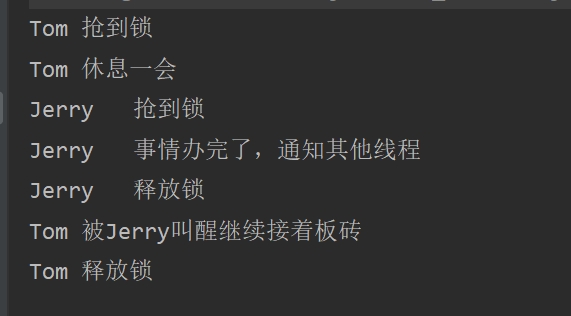
Condition顺序通知
ReentrantLock lock = new ReentrantLock();
Condition dad = lock.newCondition();
Condition mom = lock.newCondition();
Condition daughter = lock.newCondition();
AtomicInteger atomicInteger = new AtomicInteger(0);
private void cook() {
try {
Thread.sleep(1000);
lock.lock();
while (atomicInteger.get() != 0) {
dad.await();
}
System.out.println(Thread.currentThread().getName() + "开始做饭了");
atomicInteger.incrementAndGet();
System.out.println(Thread.currentThread().getName() + "发现没有土豆,通知妈妈买土豆。。");
mom.signal();
while (atomicInteger.get() != 3) {
System.out.println("===============");
dad.await();
}
} catch (Exception e) {
e.printStackTrace();
} finally {
System.out.println("饭做好了。。。。");
lock.unlock();
}
}
private void byTomato() {
try {
System.out.println(Thread.currentThread().getName() + "等待任务。。。");
lock.lock();
while (atomicInteger.get() != 1) {
mom.await();
}
System.out.println(Thread.currentThread().getName() + "接到通知去买土豆。。。");
System.out.println(Thread.currentThread().getName() + "把土豆买回来了,发现没盐,通知女儿买盐");
} catch (Exception e) {
e.printStackTrace();
} finally {
atomicInteger.incrementAndGet();
daughter.signal();
lock.unlock();
}
}
private void bySalt() {
try {
System.out.println(Thread.currentThread().getName() + "等待任务。。。");
lock.lock();
while (atomicInteger.get() != 2) {
daughter.await();
}
System.out.println(Thread.currentThread().getName() + "接到通知去买盐。。。");
System.out.println(Thread.currentThread().getName() + "把盐买回来了。。。");
} catch (Exception e) {
e.printStackTrace();
} finally {
atomicInteger.incrementAndGet();
dad.signal();
lock.unlock();
}
}
public static void main(String[] args) throws InterruptedException {
LockConditionDemo lockConditionDemo = new LockConditionDemo();
new Thread(() -> lockConditionDemo.cook(), "爸爸").start();
new Thread(() -> lockConditionDemo.byTomato(), "妈妈").start();
new Thread(() -> lockConditionDemo.bySalt(), "女儿").start();
}控制台运行结果
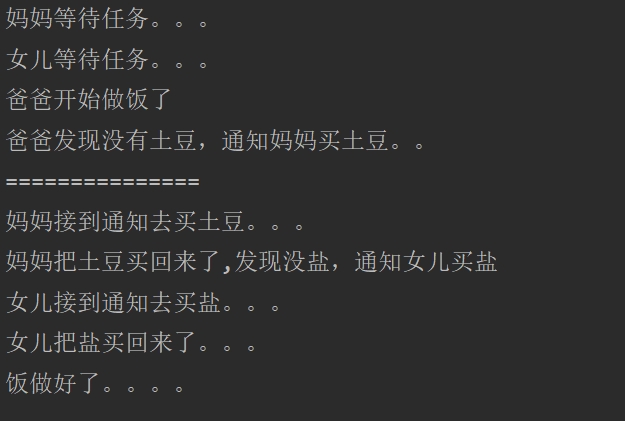
1.3 注意事项
- await需要与signal成对出现,否则会造成线程一致阻塞,没有唤醒操作
- await和signal方法需要在持有锁的情况下执行
- 先执行signal,再执行await会造成线程一致阻塞
1.4 源码解析
1) 类关系图
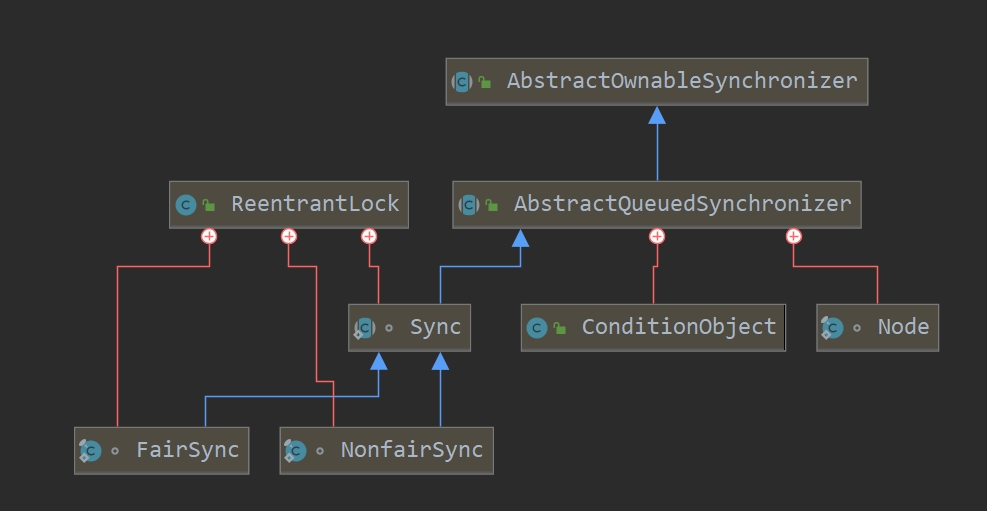
2) ReentrantLock结构
class ReentrantLock{
private final Sync sync;
// 静态抽象内部类Sync,继承了AQS
abstract static class Sync extends AbstractQueuedSynchronizer {}
// 静态内部类NonfairSync,继承了Sync。非公平锁的实现
static final class NonfairSync extends Sync {}
// 静态内部类FairSync,继承Sync。公平锁的实现
static final class FairSync extends Sync {}
// 无参构造方法,默认创建了非公平锁
public ReentrantLock() {
sync = new NonfairSync();
}
// 有参构造,根据传入的boolean类型,决定创建公平还是非公平锁
public ReentrantLock(boolean fair) {
sync = fair ? new FairSync() : new NonfairSync();
}
public void lock() {
sync.lock();
}
public void unlock() {
sync.release(1);
}
}3) AbstractQueuedSynchronizer
抽象的队列同步器,简称AQS。ReentrantLock的核心就是通过AQS来实现的。
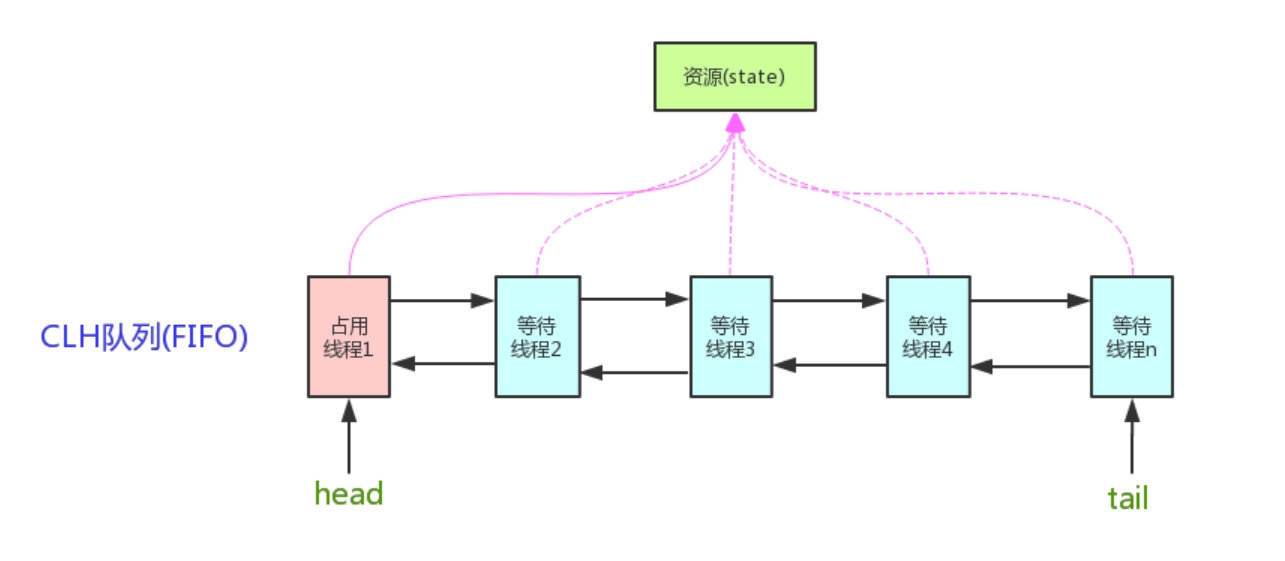
AbstractQueuedSynchronizer结构
abstract AbstractQueuedSynchronizer{
/*
* state=1,代表当前锁已被持有
* state=0,代表当前没有线程持有
*/
private volatile int state;
// 链表尾节点
private transient volatile Node tail;
// 链表头节点
private transient volatile Node head;
static final class Node {
// Node节点的状态值
volatile int waitStatus;
// 前置节点
volatile Node prev;
// 后置节点
volatile Node next;
// 下个等待的节点
Node nextWaiter;
// 当前节点的线程
volatile Thread thread;
}
// Used by addWaiter
Node(Thread thread, Node mode) {
this.nextWaiter = mode;
this.thread = thread;
}
}4) 从lock方法出发,以非公平锁为例

final void lock() {
/*
* 调用AQS的compareAndSetState,该方法使用cas来保证了操作的原子性。
* 将AQS的state变量从0改为1,
* 返回true,代表获取到锁,否则失败。
*/
if (compareAndSetState(0, 1))
/*
* state修改成功,设置独占资源的线程为当前线程
* setExclusiveOwnerThread方法是AbstractOwnableSynchronizer类方法
* AbstractOwnableSynchronizer一个抽象类,也是AQS的父类
*/
setExclusiveOwnerThread(Thread.currentThread());
else
/*
* 修改state变量失败
* 进入AQS的acquire方法
*/
acquire(1);
}4.1) AQS的acquire方法
public final void acquire(int arg) {
/*
* 这里执行三个方法
* tryAcquire 再次尝试获取锁
* addWaiter 创建Node节点,进入等待队列
* acquireQueued 执行线程阻塞
*/
if (!tryAcquire(arg) &&
acquireQueued(addWaiter(Node.EXCLUSIVE), arg))
selfInterrupt();
}AQS的tryAcquire方法是直接抛出了异常
protected boolean tryAcquire(int arg) { throw new UnsupportedOperationException(); }NonfairSync重写了tryAcquire方法,
// 重写AQS的tryAcquire方法 protected final boolean tryAcquire(int acquires) { return nonfairTryAcquire(acquires); }重写的方法里直接调用了Sync类的nonfairTryAcquire方法

final boolean nonfairTryAcquire(int acquires) { // 拿到当前线程 final Thread current = Thread.currentThread(); // 获取AQS的state变量值 int c = getState(); if (c == 0) { // state==0,代表当前没有线程持有锁,这里就尝试获取锁 if (compareAndSetState(0, acquires)) { setExclusiveOwnerThread(current); return true; } } else if (current == getExclusiveOwnerThread()) { // 如果当前线程等于持有锁的线程,这里就是锁的重入。进入一次则+1 int nextc = c + acquires; if (nextc < 0) // overflow throw new Error("Maximum lock count exceeded"); // 这里修改的是AQS的state值 setState(nextc); return true; } // 条件都不满足,则返回false return false; }
4.2) addWaiter方法(tryAcquire返回false,取反则继续执行此方法)
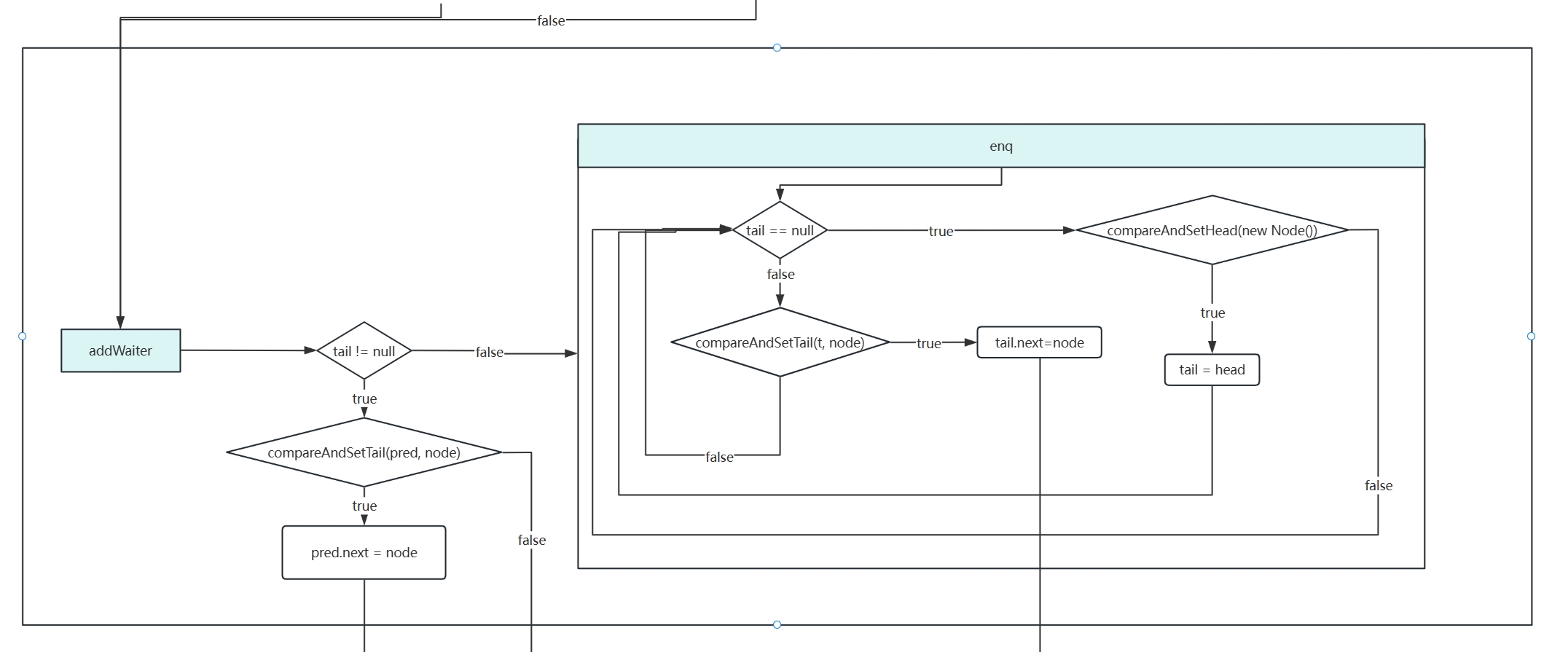
/*
* 传入的mode值为Node.EXCLUSIVE
* Node.EXCLUSIVE = null
* 所以传入的mode = null
*/
private Node addWaiter(Node mode) {
// 创建Node节点
Node node = new Node(Thread.currentThread(), mode);
// tail=尾节点
Node pred = tail;
if (pred != null) {
// 设置新节点的前置节点=尾节点
node.prev = pred;
// CAS操作,将尾节点修改为创建的新节点
if (compareAndSetTail(pred, node)) {
// 之前尾节点的后置节点=创建的新节点
pred.next = node;
// 返回创建的新节点
return node;
}
}
// 尾节点==null,进入链表的初始化
enq(node);
// 返回创建好的节点
return node;
}
// 链表初始化操作
private Node enq(final Node node) {
for (;;) {
Node t = tail;
if (t == null) { // Must initialize
// 尾节点==null,执行初始化操作
if (compareAndSetHead(new Node())) // CAS操作,创建一个空节点,并使头节点=创建的空节点
tail = head;// 尾节点=头节点,这时首尾都是这个空节点
} else {
// 循环第二次,此时链表初始化已完成
node.prev = t; // 创建的节点的前置节点=尾节点
if (compareAndSetTail(t, node)) {// CAS操作,将尾节点设置为创建的新节点
t.next = node; // 之前尾节点的后置节点设置为创建的新节点。此时创建的新节点入链完成
return t;
}
}
}
}4.3) acquireQueued
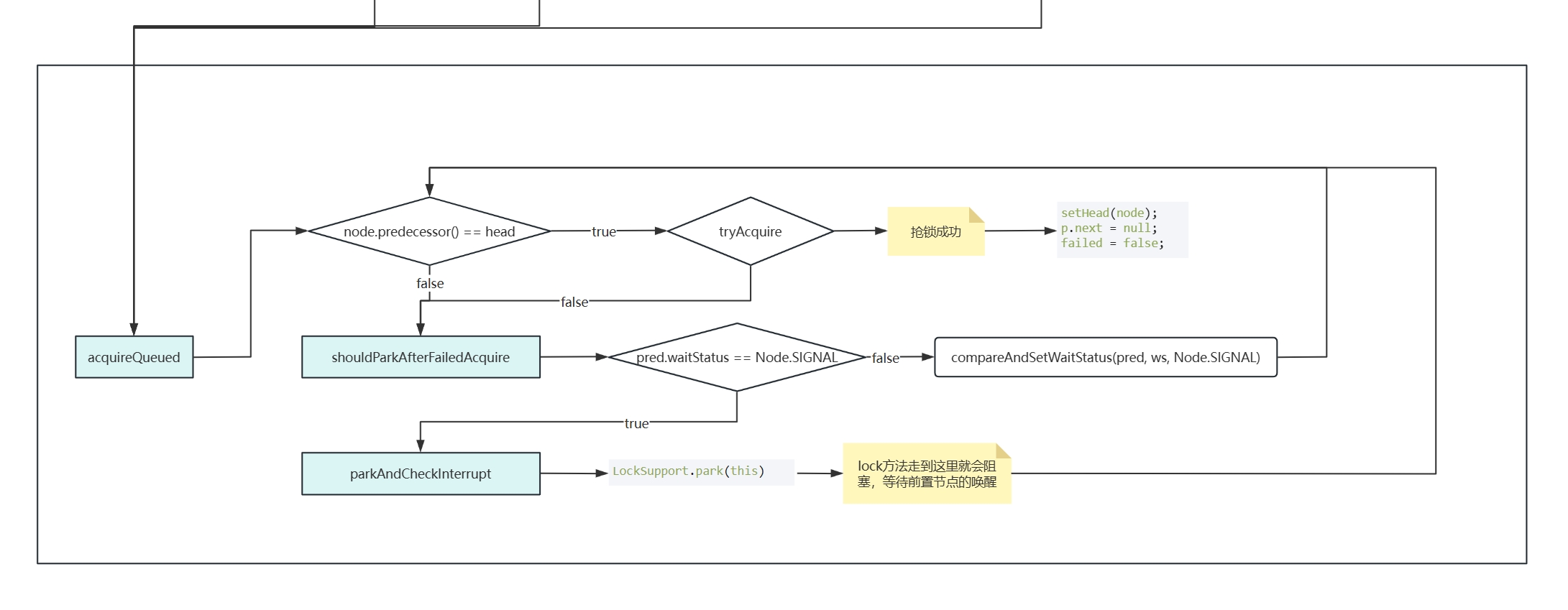
// 这里Node传入的是创建的新节点
final boolean acquireQueued(final Node node, int arg) {
boolean failed = true;
try {
boolean interrupted = false;
// 无条件循环体
for (;;) {
// 获取到前置Node,此时前直接点就是head
final Node p = node.predecessor();
// 再次尝试获取锁,获取锁失败
if (p == head && tryAcquire(arg)) {
/*
* 此时前置节点线程已unlock,此线程已获取到锁
* 设置head节点为本节点,将前置节点的next属性置为null。
*/
setHead(node);
p.next = null; // help GC
failed = false;
return interrupted;
}
/*
* 第一次循环,前置节点的witeStatus值改为-1,shouldParkAfterFailedAcquire返回fasle,继续下一次循环
* 第二次循环,则进入packAndCheckInterrupt方法,线程就阻塞在这里
* 直到前置节点调用了unlock方法,LockSupport会给此线程通行证,则进入下一次循环
*/
if (shouldParkAfterFailedAcquire(p, node) &&
parkAndCheckInterrupt())
interrupted = true;
}
} finally {
if (failed)
cancelAcquire(node);
}
}
/*
* 修改Node节点的witeStatus值为-1
*/
private static boolean shouldParkAfterFailedAcquire(Node pred, Node node) {
//获取到前置节点的wateState值
int ws = pred.waitStatus;
//Node.SIGNAL=-1
if (ws == Node.SIGNAL)
return true;
if (ws > 0) {
do {
node.prev = pred = pred.prev;
} while (pred.waitStatus > 0);
pred.next = node;
} else {
//修改前置节点的waitState为-1
compareAndSetWaitStatus(pred, ws, Node.SIGNAL);
}
return false;
}
/*
* 调用LockSupport.park()方法,阻塞线程。
* 此处,我们的lock方法就阻塞在这里,也就完成了入队和等待的工作
*/
private final boolean parkAndCheckInterrupt() {
// 此处则将当前线程阻塞。等待前置线程执行unlock方法
LockSupport.park(this);// LockSupport会在后续讲解,主要就是使用底层unsafe类来实现线程的阻塞和唤醒
return Thread.interrupted();
}4.4 lock方法就完成了线程进入等待队列和阻塞的操作
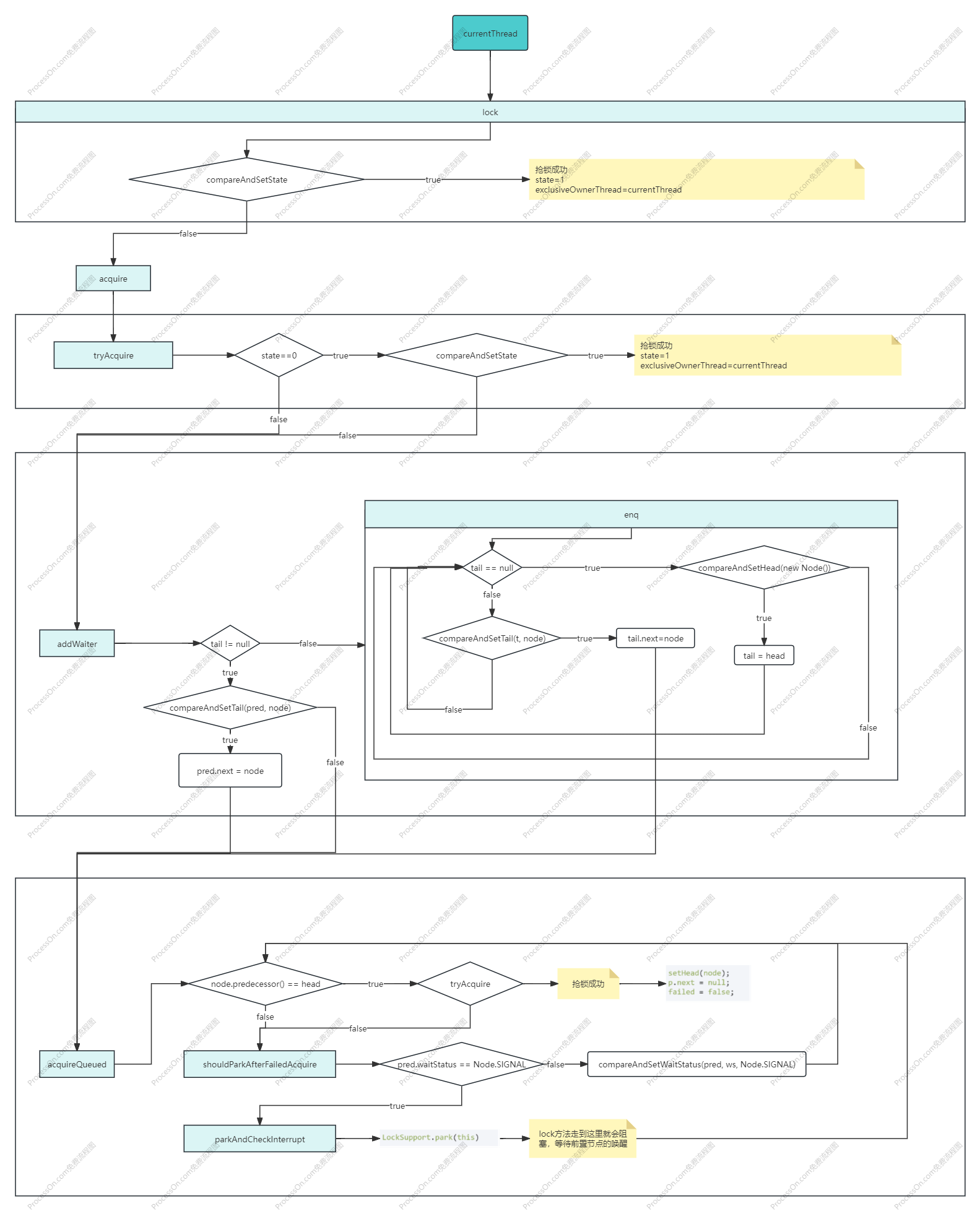
5) unlock原理
public void unlock() {
sync.release(1); //调用AQS的release方法
}5.1) AQS的release源码
public final boolean release(int arg) {
if (tryRelease(arg)) { // 这里调用ReentrantLock.Sync.tryRelease方法
Node h = head; // 拿到头节点
if (h != null && h.waitStatus != 0)
unparkSuccessor(h);// 进行后置节点的唤醒操作
return true;
}
return false;
}5.2) ReentrantLock.Sync.tryRelease源码
protected final boolean tryRelease(int releases) {
// 获取AQS的state值
int c = getState() - releases;
if (Thread.currentThread() != getExclusiveOwnerThread())// 判断当前线程是否等于持有锁的线程
throw new IllegalMonitorStateException();
boolean free = false;
if (c == 0) {
// 如果c == 0,表示已经到多重锁的最外层,可以释放锁资源了。
free = true;
// 设置当前占有锁资源的线程为null
setExclusiveOwnerThread(null);
}
// 设置AQS的state值
setState(c);
return free;
}5.3) AQS.unparkSuccessor方法源码
private void unparkSuccessor(Node node) {
//ws = -1
int ws = node.waitStatus;
if (ws < 0)
// 修改头节点的waitStatus值为0
compareAndSetWaitStatus(node, ws, 0);
// 获取到头节点的下一个节点
Node s = node.next;
if (s == null || s.waitStatus > 0) {
s = null;
for (Node t = tail; t != null && t != node; t = t.prev)
if (t.waitStatus <= 0)
s = t;
}
if (s != null)
// 唤醒下一个排队的线程
LockSupport.unpark(s.thread);
}2 synchorized
2.1 使用示例
2.1.1 锁代码块
static String LOCK_STR = "LOCK";
public void syncMethod1() {
// synchronized关键字锁对象的方式
synchronized (this) {
}
}
public void syncMethod3() {
// synchronized关键字锁静态变量
synchronized (LOCK_STR) {
}
}2.1.2 方法上加synchorized关键字
//普通方法上加锁,代表锁的是当前对象
public synchronized void syncMethod2() {
}
//静态方法枷锁,代表锁的是当前对象对应的Class
public synchronized static void syncMethod4(){
}2.2 阻塞和唤醒
public synchronized void method1() {
System.out.println(Thread.currentThread().getName() + "持有锁");
try {
System.out.println(Thread.currentThread().getName() + "进入阻塞");
this.wait();
} catch (InterruptedException e) {
e.printStackTrace();
}
System.out.println(Thread.currentThread().getName() + "退出");
}
public synchronized void method2() {
System.out.println(Thread.currentThread().getName() + "持有锁");
System.out.println(Thread.currentThread().getName() + "通知阻塞线程");
this.notify();
System.out.println(Thread.currentThread().getName() + "退出");
}
public static void main(String[] args) {
SynchorizedDemo demo = new SynchorizedDemo();
new Thread(() -> demo.method1(), "A-Thread").start();
new Thread(() -> demo.method2(), "B-Thread").start();
}执行结果
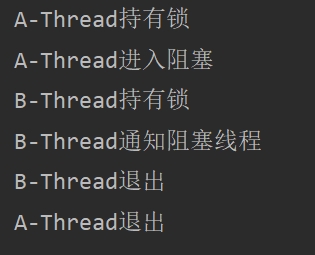
lock3 注意事项
- wait和notify成对出现
- 必须在持有锁的情况下使用
2.3 synchorized实现原理
2.3.1 字节码角度
- 同步代码块,通过monitorenter和monitorexit实现
- 同步方法,通过ACC_SYNCHONIZED访问标识,会先检查方法是否由ACC_SYHCHONIZED标识,如果有会去竞争锁,执行完成释放锁
- 静态同步方法,通过ACC_STATIC和ACC_STATIC_SYNCHONIZED标识
示例
public class SyncDemo {
static String LOCK_STR = "LOCK";
public void syncMethod1() {
synchronized (this) {
}
}
public void syncMethod3() {
synchronized (LOCK_STR) {
}
}
public synchronized void syncMethod2() {
}
public synchronized static void syncMethod4() {
}
}编译,得到class文件
javac SyncDemo.javajavap对SyncDemo.class字节码进行反汇编
javap -c SyncDemo.class返回如下结果
Compiled from "SyncDemo.java"
public class com.cqsiri.jucstudy.sync.SyncDemo {
static java.lang.String LOCK_STR;
public com.cqsiri.jucstudy.sync.SyncDemo();
Code:
0: aload_0
1: invokespecial #1 // Method java/lang/Object."<init>":()V
4: return
public void syncMethod1();
Code:
0: aload_0
1: dup
2: astore_1
3: monitorenter // 获取锁
4: aload_1
5: monitorexit // 释放锁
6: goto 14
9: astore_2
10: aload_1
11: monitorexit // 异常退出释放锁
12: aload_2
13: athrow
14: return
Exception table:
from to target type
4 6 9 any
9 12 9 any
public void syncMethod3();
Code:
0: getstatic #2 // Field LOCK_STR:Ljava/lang/String;
3: dup
4: astore_1
5: monitorenter // 获取锁资源
6: aload_1
7: monitorexit // 释放锁
8: goto 16
11: astore_2
12: aload_1
13: monitorexit // 异常释放锁
14: aload_2
15: athrow
16: return
Exception table:
from to target type
6 8 11 any
11 14 11 any
// 方法上加上synchorized关键字
public synchronized void syncMethod2();
Code:
0: return
// 方法上加上synchorized关键字
public static synchronized void syncMethod4();
Code:
0: return
static {};
Code:
0: ldc #3 // String LOCK
2: putstatic #2 // Field LOCK_STR:Ljava/lang/String;
5: return
}2.3.2 底层原理
ObjectMonitor 管程,ObjectMonitor会记录锁被谁持有,进入了几次等信息
3 synchorized和ReentrantLock的区别
- synchronized是java关键字,Lock是java类
- synchronized会自动释放锁,Lock需要在finally中手动释放,否则容易产生死锁,Lock可以判断是否获取到锁
- synchronized的锁可重入,不可中断,非公平。Lock的锁可重入,可中断,可公平
